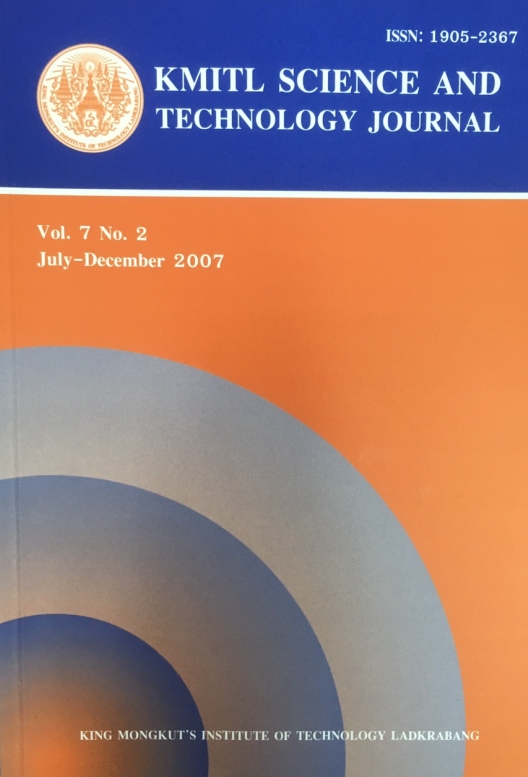GENETICALLY MODIFIED SOY IN LOCAL TOFU: EFFECT OF TOFU PREPARATION ON TRANSGENIC ELEMENT EPSPS (5-ENOLPYRUVYLSHIKIMATE-3-PHOSPHATE SYNTHASE)
Main Article Content
Abstract
Tofu (soybean curd) and its derivatives are not only the principal protein component of meals for Asians and vegetarians but are also a popular side dish for Westerners because it is a good source of proteins. However, consumption of tofu may now have a perceived risk because the tofu may be contaminated with transgenic elements such as the cauliflower mosaic virus (CaMV) 35S promoter, EPSPS (5-enolpyruvylshikimate-3-phosphate synthase) and the nopalin synthase (nos) terminator. Although no evidence has been found for an effect of the contaminated elements in tofu on human health, and food processing degrades the DNA, consumers still worry. So, to relieve apprehension of the consumers, tofu from markets in Bangkok and the vicinity at Bangkok were randomly sampled and examined for the transgenes by PCR. Genetically modified soybeans were also analyzed to study the effect of processing steps on degradation of EPSPS during the process of tofu making. During tofu processing, samples were taken from each step to analyse for the quantity of EPSPS by PCR-ELISA. Results indicate 3 out of 106 samples (ca. 2.8%) were contaminated with CaMV 35S promoter, nos terminator DNA fragments and EPSPS. In addition, EPSPS content in tofu prepared from GM soybeans was not affected by the tofu making process.
Keywords: Tofu, transgenes, EPSPS, tofu processing step
Corresponding author: E-mail: wongwath@alpha.tu.ac.th
Article Details
Copyright Transfer Statement
The copyright of this article is transferred to Current Applied Science and Technology journal with effect if and when the article is accepted for publication. The copyright transfer covers the exclusive right to reproduce and distribute the article, including reprints, translations, photographic reproductions, electronic form (offline, online) or any other reproductions of similar nature.
The author warrants that this contribution is original and that he/she has full power to make this grant. The author signs for and accepts responsibility for releasing this material on behalf of any and all co-authors.
Here is the link for download: Copyright transfer form.pdf
References
[2] www.http://en.wikipedia.org/wiki/Tofu#History
[3] Messina, M. 1995. Modern application for an ancient bean: soybean and the prevention and treatment of chronic disease, Journal of Nutrition, 125, 567S-569S.
[4] Anderson, J.J.B., Anthony, M., Messina, M. and Garner, S.C. 1999. Effect of phytoestrogens on tissues, Nutrition Research Review, 12, 75-116.
[5] Anklam, E., Gadani, F., Heinze, P., Pijnenburg, H. and van Den Eede, G. 2002. Analytical methods for detection and determination of genetically modified organisms in agricultural crops and plant-derived food products, European Food Research Technology, 214, 3-26.
[6] Nordlee, J.A. Taylor, S.L. Townsend, J.A. Thomas, L.A. and Bush, R.K. 1996. Identification of Brazil nut allergen in transgenic soybean, North England Journal Medicine, 92, 668-692.
[7] Jonas, D.A., Elmadfa, I., Engel, K.-H., Heller, K.J., Kozianowski, G., Konig, A., Muller, D., Narbonne, J.F., Wackernagel, W. and Kleiner, J. 2001. Safety considerations of DNA in food, Annals of Nutrition & Metabolism, 45, 235-254.
[8] Jonas, D.A., Elmadfa, I., Engel, K.-H., Heller, K.J., Kozianowski, G., Konig, A., Muller, D., Narbonne, J.F., Wackernagel, W. and Kleiner, J. 2001. Safety consideration of DNA in food, Annals of Nutrition & Metabolism, 45, 235-254.
[9] Yi-Cheng, Sun, Yan-Cheng, Chen, Zhe-Xiam, Tian et al. 2005. Novel AroA with high tolerance to glyphosate, encoded by a gene of Pseudomonas putida 4G-1 isolated from an extremely polluted environment in China, Applied and Environmental Microbiology, 71 (8), 4771-4776.
[10] Studer, E. 1997. Nachweis des gentechnish veranderten “Maximizer”-Mais mittels der Polymerase-Ketten reaction (PCR), Mitt. Gebiete Lebensm. Hyg., 88, 515-524.
[11] Lipp, M., Brodmann, P., Pietsch, K., Pauwels, J. and Anklam, E. 1999. IUPAC collaborative trial study of a method to detect genetically modified soybeans and maize in dried powders, Journal of AOAC International, 82, 923-929.
[12] Sambrook, J., Fritsch, E.F. and Maniatis, T. 1989. Molecular Cloning: A Laboratory Manual, 2ed. Cold Spring Harbor Laboratory Press.
[13] Zhang, M., Gao, X., Yu, Y., Ao, J., Qin, J., Yao, Y. and Li, Q. 2007. Detection of Roundup Ready Soy in highly processed products by triplex nested PCR, Food Control., 18, 1277-1281.
[14] Kharazmi, M., Bauer, T., Hammes, W.P. and Hertel, C. 2003. Effect of food processing on the fate of DNA with regard to degradation and transformation capability in Bacillus subtilis, System Apply Microbiology, 26, 495-501.
[15] Moriuchi, R., Monma, K., Sagi, N., Uno, N. and Kamata, K. 2005. Applicability of quantitative PCR to soy proceesed foods containing Roundup Ready Soy, Food Control, 16, 1-5.


